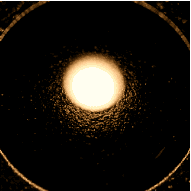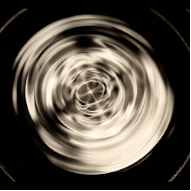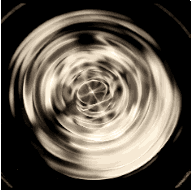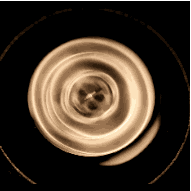Sonic Sculptures
56 cm x 42 cm
Edition of 8
2011
Like a 3-D take on Jackson Pollock, the latest work by the artist Martin Klimas begins with splatters of paint in fuchsia, teal and lime green, positioned on a scrim over the diaphragm of a speaker - then, the volume is turned up. For each image, Klimas selects music — typically something dynamic and percussive, like Karlheinz Stockhausen, Miles Davis or Kraftwerk — and the vibration of the speaker sends the paint aloft in patterns that reveal themselves through the lens of his Hasselblad.
For 'Sonic Sculptures', Klimas spent about 1,000 shots to produce the final images from his studio in Düsseldorf, Germany. In addition to the obvious debt owed to abstract expressionism, Klimas says his major influence was Hans Jenny, the father of cymatics, the study of wave phenomena.
Julie Bosman - The New York Times Magazine
Sonic Sculptures
100 cm x 135 cm
Edition of 5
2011
"Miles at the Fillmore" erreicht Platz 1 in den Jazz Charts
Artwork für Miles Davis Album Cover
The Bootleg Series Vol. 3 von 1970
The album contains more than two hours of previously unreleased music, recorded at the "Fillmore West" in San Francisco, and presented by the 1970 line-up with Miles Davis, Chick Corea, Keith Jarrett, Dave Holland, Jack DeJohnette, Airto Moreira and Steve Grossman.
Martin Klimas also used the song "Bitches Brew" from this period for his recent work "Sonic Sculptures". Appearing on the cover this picture will become part of the history of Davis' music.
"Soundworks" at Foley Gallery, New York
Soloshow 20.04. - 22.05.2016
In Soundworks, Klimas continues to explore the question, "What does sound look like?", translating sound to a single moment that we can actually see. In SONIC , he uses well-known songs by musicians such as Miles Davis or Daft Punk. In Sound Explosions , Klimas uses original compositions. In collaboration with several musicians, Klimas asked that they create "patches" of sound using analogue synthesizers. The synthesizers—made between 1930 and 1990—are presented as to prologue the intricate vibrations of sound, which he animates with powdered pigments. Reflection, interference, refraction and diffraction: basic wave phenomena generate the differences in sound that we can hear as a beat.
To create the images, he places a scrim over the speaker diaphragm and carefully places the chosen pigments for the sound reaction. Then, using high-speed camera technology, he captures the kaleidoscopic chaos that appears when the sound begins. Each pigment abstraction will be paired with its photographic counterpart; a detail of the machine that created it.
The artist removes organized sound, or beats, in his series Pure Tones. Here he employs a frequency generator, outputting the most basic building blocks of music. Sine tones are used to stimulate the surface of water and Klimas photographs the resulting "standing waves". Some of these photographs will be displayed as lenticular prints, giving the viewer a four-faced view of each tone.
press release "The New Yorker"
more info
Pigment Explosions
Diptychon
74 cmH x 2 Pieces a 54 cmW
Edition of 8
2013
Pigment Explosions was created partially through short original musical sequences using synthesizers between 1930 and 1990. The work is a series of diptychs allowing the viewer to see the wires, cables, and dials that create these colorful symphonies. Quirkily scientific and unabashedly playful, Sound Explosions evokes the joy of sound through the vision of sight.
featureshoot.com
more info
Villagevoice
May 2016
more info
Pure Tones
30 cm x 30 cm
Edition of 8
2014
Pure Tones
The artist removes organized sound, or beats, in his series Pure Tones. Here he employs a frequency generator, outputting the most basic building blocks of music. Sine tones are used to stimulate the surface of water and Klimas photographs the resulting "standing waves". Some of these photographs will be displayed as lenticular prints, giving the viewer a four-faced view of each tone.
Artwork für Pink Floyd Album
3D Lenticular Artwork for The Endless River Album
November 2014
more info
Cover ARTnews
November 2013 Issue
ARTnews, the most widely read art magazine in the world brings Terry Riley, "A Rainbow in curved Air" on its November Cover.
more info
SONIC
Foley Gallery, 97 Allen Street, New York
Soloshow 18.09. - 03.11.2013
Opening 18.09.2013

High speed stop motion photography has always held the promise of the unreal and the fantastic, capturing events that normally pass us by in the blink of an eye. Starting with Eadweard Muybridge's galloping horse images for Leland Stanford in the 19th century and followed by Dr. Harold Edgerton's scientific studies of bullets passing through apples and milk droplets jumping into perfect crowns, these kinds of images deftly combined technology and art, mixing astonishing subject matter and bleeding edge technical prowess. German photographer Martin Klimas is one of a new generation of artists (including Ori Gerhst and Shinichi Maruyama among others) continuing in this line of visual investigation, pushing the newest tools further and further. While his previous projects have included the split second breaking of falling porcelain figurines and projectile smashed flower vases, his new works go one step further to document the invisible, in this case, the explosive power of sound.
We might normally think about visualizing sound as waves, measuring their frequency and amplitude with an oscilloscope or charting their loudness in decibels. But Klimas has crafted an ingenious new method of seeing the energy of sound, pulling a thin membrane across the top of a loudspeaker and letting the blasts of sound create upward vibrations, almost like a drum. He then pools different combinations of watery neon paint on top of the membrane and when the sound hits, they jump into the air with the gestural power of an action painter. Captured in fractions of a second and seemingly frozen solid, they take on remarkably different forms, depending on the music that was playing: Wagner and Kraftwerk splash into millions of tiny droplets, while Miles Davis and Prince swirl into elongated squiggles. Hot combinations of exuberant colors make the bursts and eruptions all the more dynamic.
It's certainly possible to geek out at this show, replaying the music in your head and trying to puzzle out why the music of John Cage, Pink Floyd, and Grace Jones looks exactly the way it does (was it the thump of the bass line, a guitar solo, or the crash of the percussion?). But the explosions of fluid paint also function as vigorous vertical abstractions, like stalagmites of instantaneous energy. In the end, when the exact right moment occurs, Klimas takes sound and gives it a dazzling visual form, allowing it to dance across the frame. Who knew the physical manifestation of sound was so flashy and effervescent?
more info
Eröffnung der neuen Oper in Linz
Soloshow 11.04.2013 - 06.07.2013
Musiktheater, Linz
Opening 11.04.2013
At the first time the complete Series of the SONIC SCULPTURES will be shown at the Opening of the new Opera in Linz, Austria.
At once, the Premiere of "Spuren der Verirrten", a Opera written by Philip Glass and Peter Handke takes place.
J'entends des couleurs
Neon Magazine
May 2013
Pavlov's Dog, Berlin
Soloshow 11.05.2012 - 09.06.2012.
Precision, accuracy and the exact preliminary planning of his scientifically set-up compositions are what make Martin Klimas' image series so unique and impressive. With his way of working Klimas constantly wanders between art and science. His role models are scientist and explorers such as Harold E. Edgerton, a pioneer of high-speed photography. The inspiration for his latest series came from natural scientist Hans Jenny and his work on Cymatics. But Klimas does not stop at the mere associative depiction of sound and has built a machine that converts sound waves into pictures. In his choice of music he does not limit himself to certain styles or periods and uses pieces such as "Transitor" by Kraftwerk as well as Carl Orff´s "Carmina Burana". Klimas most famous series are pictures of porcelain figures photographed in the moment that they were dropped from a height of three metres with a high-speed camera.
more info
Musik zum Sehen
TV Feature WDR
WestArt
Juin 2012
Neue Deutsche Welle
Weltwoche
Juin 2012

Ein Spritzer Fuchsia. Ein Schauer Limone. Ein Brodem Aquamarin. Sage einer, Musik hätte keine Persönlichkeit und kein Geschlecht. Dies ist das Bild für jene, die für die Beweislage eine Fotografie benötigen. Was hier ihr Naturell offenbart – ihre ekstatische Verfasstheit, ihr drängendes, offensichtlich männliches Ego –, das ist Steve Reichs Komposition «Drumming». Das Stück, ein Highlight der Minimal Music, wurde 1971 für neun Percussions-Instrumente und drei Sängerinnen geschrieben; Melodiemodelle, die sich beständig wiederholen, sich verschieben und asynchron gegeneinander laufen. Phasentechnik nannte der amerikanische Avantgardist das Konzept dieser Stücke.
Es mag ein Zufall sein, doch 1971 ist auch das Geburtsjahr von Martin Klimas. Der deutsche Fotograf hat Reichs Kunstmusik in dieses Kunstbild übersetzt, mit Fuchsia, Limone, mit Aquamarin: «Drumming» fotografiert in Cinema-Color und in Hochgeschwindigkeit, in Farbe und in Bewegung. «Sonic Sculptures» taufte er das Ergebnis und machte dabei Ähn- liches wie der längst vergessene Schweizer Naturforscher Hans Jenny (1904–1972). Der erfand den Begriff Kymatik für die Visualisierung von Klängen und Wellen.
Wenn es Action-Painting gibt, wird es auch Action-Photography geben. New-Wave-Fotografie, die Neue Deutsche Welle im Bild. Klimas ist vielleicht ihr erster Schüler. Er hat Jennys Verfahren, Schwingungen in Flüssigkeit zu übersetzen, fürs Computerzeitalter neu erfunden. Dazu nimmt er sich einen Lautsprecher mit einer trichterförmigen Membran und einen be- spannten Keilrahmen. Auf die Membran trägt er Farbe auf, und alles Folgende funktioniert nach dem Motto «Pump up the Volume». Klimas zieht den Lautstärkeregler hoch und überlässt die Entstehung des Bildes sich selber. Die Vibration des Lautsprechers erzeugt Farbmuster, die schliesslich die clevere Beleuchtung, die clevere Videotechnik und Klimas clevere Hasselblad-Linse enthüllen. «Sonic Sculptures» bilden ein synästhetisches Zusammenspiel aus Klang, Form und Farbe. Martin Klimas, ein Art Jackson Pollock auf der Lauer.
Und wozu das Ganze? Weil es ganz einfach schön ist, festzustellen, dass Musik ein lebendiger Organismus ist und ein Wesen in der dritten Dimension. Wortwörtlich kann man von ihr berührt werden, bewegt, angesprungen, angefallen und angeheitert. Wer nicht hören kann, wird sehen dürfen.
Klangexplosionen
ZEIT Magazine
April 2012
Painting With Sound
The New York Times Magazine
January 2012

Like a 3-D take on Jackson Pollock, the latest work by the artist Martin Klimas begins with splatters of paint in fuchsia, teal and lime green, positioned on a scrim over the diaphragm of a speaker. Then the volume is turned up. For each image, Klimas selects music — typically something dynamic and percussive, like Karlheinz Stockhausen, Miles Davis or Kraftwerk — and the vibration of the speaker sends the paint aloft in patterns that reveal themselves through the lens of his Hasselblad. Klimas rose to prominence in the art world four years ago for a series of photos that captured porcelain figurines just as they shattered. For this series, Klimas spent six months and about 1,000 shots to produce the final images from his studio in Düsseldorf, Germany. In addition to the obvious debt owed to abstract expressionism, Klimas says his major influence was Hans Jenny, the father of cymatics, the study of wave phenomena. The resulting images are Klimas's attempt to answer the question "What does music look like?"
more info

























































































